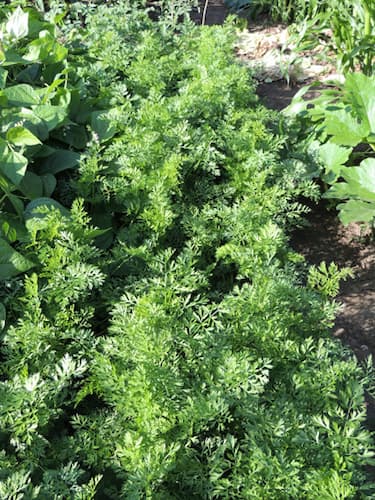How to Control Garden Moles and Voles

Garden Moles and Voles are Underground Tunnel Digging Pests
Garden moles and voles are common lawn and garden pests. In the lawn, their tunneling activity can create extensive damage. In the garden, the tunneling activity of moles can disturb plant roots. This can be followed by voles using the tunnels in search of garden goodies. The voles eat root crops, especially carrots (pictured above). This guide shows you how to control moles and voles in your yard and garden.
It is usually easy to spot their presence from the tunnels they dig just below the surface of the soil.
About Garden Moles
Moles are small mammals that live their life underground, rarely coming topside. They eat primarily earthworms, grubs, and insects. They can eat almost their weight each day. Moles produce a litter of 3-4 babies every spring. The babies grow quickly to adult size.
A Big Mole: The “Russian Mole” grows up to 14″ from head to the tip of the tail. Aren’t you glad they do not live in your lawn!?
Moles dig the main tunnel in search of food. From the main tunnel, they create numerous “feeder” tunnels which they use in search of food. They actively dig tunnels in search of food all year. In the winter this activity continues beneath the snow.
Moles are solitary creatures. They do not live in groups. With a big appetite, a single mole can create a huge tunnel system.
Garden Moles and Voles are common lawn and garden pests. In the lawn, their tunneling activity can create extensive, unsightly damage. In the garden, the tunneling activity of moles can disturb plant roots. This can be followed by voles using the tunnels in search of garden goodies. Damage caused by their underground activity is often not spotted on a timely basis.
About Voles
Voles are similar to field mice. They tend to travel above ground, leaving a brown trail. These rodents are also opportunists, using mole tunnels to travel in search of food. As a result, homeowners and gardeners often mistake them for moles. Their primary diet consists of plants, including your garden root crops.
How to Control Garden Moles and Voles
Poison Bait- This usually consists of poisoned grains. Pour the bait into active tunnels. Moles and voles will hopefully consume it and die. You will rarely see the dead animal.
Important caution for gardeners- Poisoned bait in the garden gets into the soil your crops use. We do not recommend poison baits in the garden.
Sonic Devices- These devices produce an ultrasonic sound, undetectable to the human ear. Placed in active tunnel areas, it is effective. The trouble is, the moles move to your neighbors’ yard and garden. Turn the device off, and they soon return.
Mouse Traps- Here’s a method that’s highly effective, inexpensive, and does not use poisons. Buy an inexpensive mouse trap. Use a bit of peanut butter for bait. Place it near an active tunnel where a hole to the surface exists. Place a five-gallon bucket or a box over the trap. Check daily. You will be amazed at how quickly this works.
Poison gas- Here’s a labor-intensive method. Find an active tunnel. Block off all exits to feeder tunnels and the end of the tunnel. Poison gas is then sent through the tunnel. It works if, and only if, you’ve caught the mole in the tunnel without a quick escape route.
Bubble Gum- Partially chew a piece or two of bubble gum. Place it in an active tunnel. The mole will eat it, but can not digest it. It blocks the intestines and they die. We are not certain if this actually works.
Related Articles
Please support our site. Shop for:
- rmmatthews100@hotmail.com
- 585-721-6528
- Rochester, NY
©1999-2024 GardenersNet.Com, All Rights Reserved

